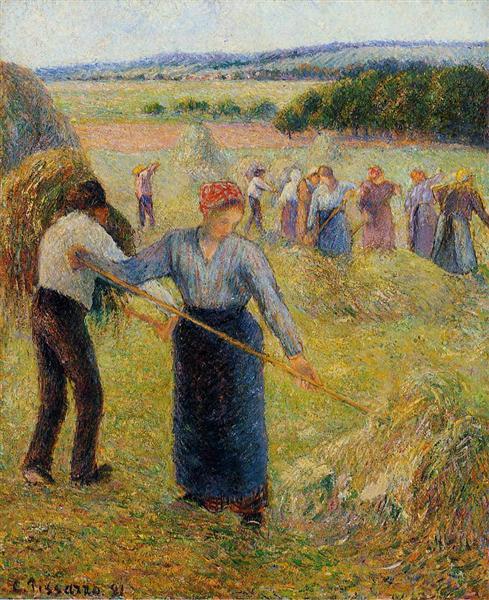Beschrijving
Camille Pissarro's 1891 painting "Haymaking at Eragny" is a magnificent example of the artist's mastery in the context of Impressionism. Known as one of the main leaders of the movement, Pissarro managed to capture the essence of rural life through his distinctive style that combines light, color and a loose brushstroke, elements that invite the viewer to experience an intimate connection with nature and human activities.
In this painting, the composition is arranged so that the viewer's gaze is guided towards the action of hay being gathered in a familiar landscape. The scene, which meanders towards the background, is populated by human figures engaged in agricultural work, seemingly integrated with their surroundings. These figures, although not intensely detailed, are vital to understanding the dynamism of the work. Through the depiction of workers in the field, Pissarro not only documents an agricultural activity, but also pays homage to human endeavour and connection to the land.
The use of color is particularly notable in “Haymaking at Eragny.” Pissarro employs a palette of warm, earthy tones that predominate in the countryside in which the scene is set. These colors, combined with brighter hints on the horizon, reflect the sunlight filtering through the atmosphere, creating a vibrant interplay between the sky and the countryside. Shadows are subtly drawn, adding depth and a sense of volume to the figures and vegetation. The impasto style he employs, where paint is applied in thick layers, allows the texture of the work to come alive, inviting the viewer to appreciate the tactile qualities of the painting medium.
As for the characters, the work presents a relatively balanced representation between the landscape and human activity. Although the figurines are rather stylized and do not focus on individual details, their postures and movements suggest the hard and laborious work that characterized agrarian life at that time. In this way, each figure becomes a symbol of collective effort, which resonated deeply in the already changing French society after the industrial revolution.
Furthermore, there is a biographical component that cannot be ignored when discussing this work. Pissarro, who spent much of his life in Eragny, a rural area north of Paris, was deeply influenced by the relationship between man and his natural environment. This painting reflects his admiration for a simple and organic life, a recurring theme in his work. With industrialisation on the rise, Pissarro's art stood as a visual testimony to rural life that was increasingly threatened by modern progress.
"Haymaking at Eragny" not only stands alongside Pissarro's other contemporary works that also celebrate rural life, but stands out as a work that encapsulates his artistic philosophy. The piece allows the viewer to immerse themselves in the pleasant atmosphere of a day's work in the countryside, taking advantage of the influence of the changing light and the beauty of human endeavor in harmony with nature. In the context of the evolution of Impressionism, this painting stands as a landmark in Pissarro's career and a celebration of the vibrant agrarian life of 19th century France. With its conjunction of masterful technique and emotive representation, "Haymaking at Eragny" remains a testament to art's ability to reflect and preserve the essence of everyday, otherwise ephemeral moments.
KUADROS ©, a famous painting on your wall.
Hand-made oil painting reproductions, with the quality of professional artists and the distinctive seal of KUADROS ©.
Painting reproduction service with satisfaction guarantee. If you are not completely satisfied with the replica of your painting, we will refund 100% of your money.

